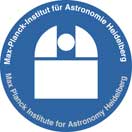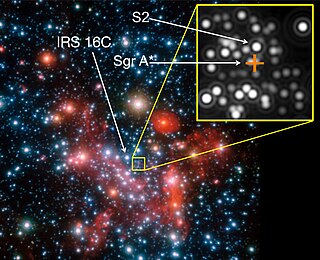Related Research Articles

Rashid Alievich Sunyaev is a German, Soviet, and Russian astrophysicist of Tatar descent. He got his MS degree from the Moscow Institute of Physics and Technology (MIPT) in 1966. He became a professor at MIPT in 1974. Sunyaev was the head of the High Energy Astrophysics Department of the Russian Academy of Sciences, and has been chief scientist of the Academy's Space Research Institute since 1992. He has also been a director of the Max Planck Institute for Astrophysics in Garching, Germany since 1996, and Maureen and John Hendricks Distinguished Visiting Professor in the School of Natural Sciences at the Institute for Advanced Study in Princeton since 2010.

A stellar black hole is a black hole formed by the gravitational collapse of a star. They have masses ranging from about 5 to several tens of solar masses. The process is observed as a hypernova explosion or as a gamma ray burst. These black holes are also referred to as collapsars.

The Max Planck Institute for Astrophysics (MPA) is a research institute located in Garching, just north of Munich, Bavaria, Germany. It is one of many scientific research institutes belonging to the Max Planck Society.
The Max Planck Institute for Extraterrestrial Physics is a Max Planck Institute, located in Garching, near Munich, Germany. In 1991 the Max Planck Institute for Physics and Astrophysics split up into the Max Planck Institute for Extraterrestrial Physics, the Max Planck Institute for Physics and the Max Planck Institute for Astrophysics. The Max Planck Institute for Extraterrestrial Physics was founded as sub-institute in 1963. The scientific activities of the institute are mostly devoted to astrophysics with telescopes orbiting in space. A large amount of the resources are spent for studying black holes in the galaxy and in the remote universe.
Annette Mairi Nelson Ferguson FRSE is a Scottish observational astrophysicist who specialises in the area of galaxy evolution. She is a professor at the Institute for Astronomy, Edinburgh, and holds the Personal Chair in Observational Astrophysics at the School of Physics and Astronomy, University of Edinburgh.

The Max Planck Institute for Gravitational Physics is a Max Planck Institute whose research is aimed at investigating Einstein's theory of relativity and beyond: Mathematics, quantum gravity, astrophysical relativity, and gravitational-wave astronomy. The institute was founded in 1995 and is located in the Potsdam Science Park in Golm, Potsdam and in Hannover where it closely collaborates with the Leibniz University Hannover. Both the Potsdam and the Hannover parts of the institute are organized in three research departments and host a number of independent research groups.

The Max-Planck-Institut für Astronomie is a research institute of the Max Planck Society (MPG). It is located in Heidelberg, Baden-Württemberg, Germany near the top of the Königstuhl, adjacent to the historic Landessternwarte Heidelberg-Königstuhl astronomical observatory. The institute primarily conducts basic research in the natural sciences in the field of astronomy.

The following outline is provided as an overview of and topical guide to astronomy:
Guinevere Alice Mei-Ing Kauffmann was born in California. She is an astrophysicist and is known for her work studying galaxies among other subjects.

Reinhard Genzel is a German astrophysicist, co-director of the Max Planck Institute for Extraterrestrial Physics, a professor at LMU and an emeritus professor at the University of California, Berkeley. He was awarded the 2020 Nobel Prize in Physics "for the discovery of a supermassive compact object at the centre of our galaxy", which he shared with Andrea Ghez and Roger Penrose. In a 2021 interview given to Federal University of Pará in Brazil, Genzel recalls his journey as a physicist; the influence of his father, Ludwig Genzel; his experiences working with Charles H. Townes; and more.
Rudolf Kippenhahn was a German astrophysicist and science author.

S2, also known as S0–2, is a star in the star cluster close to the supermassive black hole Sagittarius A* (Sgr A*), orbiting it with a period of 16.0518 years, a semi-major axis of about 970 au, and a pericenter distance of 17 light hours – an orbit with a period only about 30% longer than that of Jupiter around the Sun, but coming no closer than about four times the distance of Neptune from the Sun. The mass when the star first formed is estimated by the European Southern Observatory (ESO) to have been approximately 14 M☉. Based on its spectral type, it probably has a mass of 10 to 15 solar masses.
Friedrich-Karl "Friedel“ Thielemann is a German-Swiss theoretical astrophysicist.
The Heidelberg Institute for Theoretical Studies was established in 2010 by SAP co-founder Klaus Tschira through his foundation, the "Klaus Tschira Stiftung", as a private, non-profit research institute. HITS conducts basic research involving the processing structuring and analysis of large amounts of data in the natural sciences, mathematics and computer science. The research topics range from molecular biology to astrophysics. Shareholders of HITS are the "HITS-Stiftung", Heidelberg University and the Karlsruhe Institute of Technology (KIT). HITS cooperates with universities and research institutes, as well as with industrial partners. The prime external funding sources are the Federal Ministry of Education and Research, the German Research Foundation and the European Union.

R136c is a star located in R136, a tight knot of stars at the centre of NGC 2070, an open cluster weighing 450,000 solar masses and containing 10,000 stars. At 142 M☉ and 3.8 million L☉, it is the one of the most massive stars known and one of the most luminous, along with being one of the hottest, at over 40,000 K. It was first resolved and named by Feitzinger in 1980, along with R136a and R136b.

VFTS 352 is a contact binary star system 160,000 light-years (49,000 pc) away in the Tarantula Nebula, which is part of the Large Magellanic Cloud. It is the most massive and earliest spectral type overcontact system known.
Benedetta Ciardi is an Italian astrophysicist.
John Antoniadis also known as Ioannis Antoniadis is a Greek astrophysicist. He is mostly known for his research of radio pulsars, a type of rapidly rotating neutron stars.
LB-1 is a binary star system in the constellation Gemini. In 2019 a paper in Nature concluded that the system contained a "monster" black hole outside of ordinary single stellar evolution parameters. However, analyses in 2020 found the original 2019 conclusion to be incorrect. Some researchers now believe the system consists of a stripped B-type star and a massive rapidly rotating Be star.
The Netherlands Research School for Astronomy is a graduate school specializing in astronomy, based in the Netherlands. This graduate school was founded in 1992.
References
- ↑ "Selma de Mink". Royal Netherlands Academy of Arts and Sciences . Retrieved January 24, 2021.
- ↑ "Selma de Mink". Black Hole Initiative. Retrieved October 27, 2020.
- ↑ "Selma E. de Mink appointed as director at the Max Planck Institute for Astrophysics". Max Planck Institute for Astrophysics. January 1, 2021. Retrieved January 24, 2021.
- ↑ Hugues, Sana; De Mink, Selma; de Koter, Alex; Langer, N.; Evans, CJ; Gieles, M; Gosset, Eric; Izzard, RG; Le Bouquin, J-B; Schneider, FRN (2012). "Binary interaction dominates the evolution of massive stars". Science. 337 (6093): 444–446. arXiv: 1207.6397 . Bibcode:2012Sci...337..444S. doi:10.1126/science.1223344. PMID 22837522. S2CID 53596517.
- ↑ Denise Chow (July 26, 2012). "Brightest and hottest stars have close, turbulent relationships, study suggets[sic]". Christian Science Monitor. Retrieved October 27, 2020.
- ↑ Natalie Wolchover (September 26, 2016). "Colliding Black Holes Tell New Story of Stars". Quanta Magazine. Retrieved October 27, 2020.
- ↑ "Pastoor Schmeitsprijs voor de Sterrenkunde voor dr. Selma de Mink". University of Groningen. May 27, 2019. Retrieved October 27, 2020.
- ↑ Merac Prize 2017